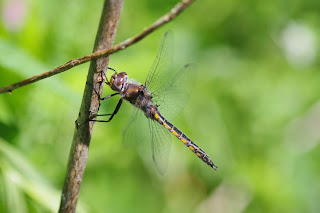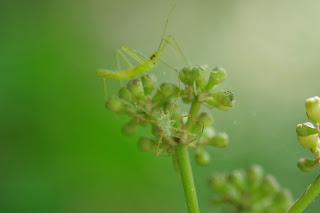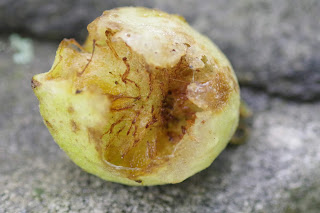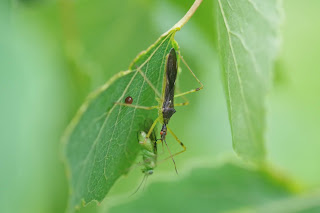Backyard Bug of the Day:
I have given up looking up dragonflies to find out their species. The books always just end up confusing me.
There were some interesting displays of insect morphology in the backyard today. I post pictures sometimes of sawfly larvae, and I am sure that it has crossed people's minds to wonder what is the difference between sawfly larva and a caterpillar, because they look very similar. Practically the same, in fact, until you get used to the differences. The first time I ever saw sawfly larvae I assumed they were caterpillars, and it took quite a while for me to find out what they really were. I had never heard of a sawfly before (which, very unhelpfully named, isn't a fly, but a wasp), and I didn't know that there was anything that looked like a caterpillar other than a caterpillar. I am not even sure that I knew that caterpillars are specifically the larvae of moths and butterflies, but I think I did. Anyway, there are several differences, including the eyes and head, but the easiest one to see is the different number of prolegs. Not that you can always see the prolegs of either, but today I happened to get pictures from the optimal angle of both a sawfly and a caterpillar to show the difference. And it is basically this: sawfly larvae have more prolegs. And what is a proleg? Well, there are true legs, which are like other insect legs, and which, as in all other insects, they have three pairs of, and are generally used for holding onto food, and then there are prolegs, which are kind of stumpy legs with teeny, tiny hooks all over them that are used for walking and climbing.
Here's a sawfly larva:
This one has eight pairs of prolegs. I don't know if that varies among species.
Here's the back end of a caterpillar. Caterpillars have up to five pairs of prolegs. There's the four pairs in the middle, and one pair in the back. Some species have fewer–looper caterpillars have two pairs in the back, and none in the middle. Too bad I didn't get a picture of one of those today...
Here's the rest of the caterpillar.
Now, another interesting display of morphology in the backyard today involves camouflage. There are a few ways to camouflage yourself if you are an insect. You can look like something else so that you can blend in, like a moth that looks like tree bark, or an insect that looks like a leaf. Or you can just look like something nothing wants to eat.
For instance, you may wonder why I took a photo of bird poop...
... until you look closely and see that the bird poop has legs...
... and is, in fact, a moth.
Looking like bird poop is a strategy used by several species of moth. Coincidentally, I saw two different species today:
Other Bugs:
The thing in the middle of the picture is not the bug. You'll have to look a bit closer to see the two bugs.
Katydid nymph
Long-legged fly
Fly killed by fungus
Caterpillar
Arachnid Appreciation:
.
.
.
.
.
.
.
.
.
.
.
.
I think this is a male six-spotted orb weaver.
The jumping spider that currently lives under the rain gauge
Crab spider
Reptile of the Day:
.
.
.
.
.
.
.
.
.
.
.
.
Once again I nearly stepped on a snake, but this one was pretty blase about it, and only moved slowly away. Another garter snake, which is mostly what I see in my backyard.
I noticed something about its eye when I looked at the pictures.
I think that cloudiness means it is about to shed its skin soon.







































































